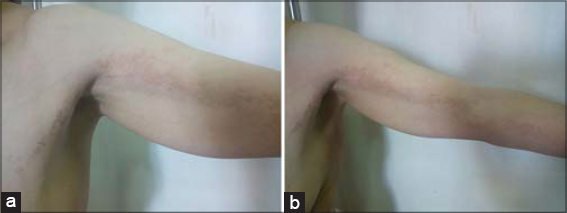Linear lichen planus
Siham Belmourida , Hind Palamino, Mariame Meziane, Laila Benzekri, Nadia Ismaili, Karima Senouci
, Hind Palamino, Mariame Meziane, Laila Benzekri, Nadia Ismaili, Karima Senouci
Department of Dermatology-Venereology, Mohammed V University, IBN Sina Hospital, Rabat, Morocco
Corresponding author: Siham Belmourida, MD
Submission: 06.11.2020; Acceptance: 14.02.2021
DOI: 10.7241/ourd.2021e.25
Cite this article: Belmourida S, Meziane M, Benzekri L, Ismaili N, Senouci K. Linear lichen planus. Our Dermatol Online. 2021;12(e):e25.
Citation tools:
Copyright information
© Our Dermatology Online 2021. No commercial re-use. See rights and permissions. Published by Our Dermatology Online.
Lichen planus is an acquired inflammatory dermatosis characterized in its classical form by shiny, flattopped, firm red papules, typically located on the flexural surfaces of the extremities [1].
We report a case of linear lichen planus (LLP) developed in a 45-year-old woman.
45-year-old patient, consulted for itchy pigmented maculopapular lesions evolving for 1 month, these lesions were located along the lines of Blaschko at the level of the anterior face of the upper left limb (Figs. 1a and 1b). Examination of the rest of the integument and mucous membranes was normal. The histological study was in favor of a pigmentogenic lichen. The patient was put on an emollient and topical corticosteroids with an improvement in the lesions but persistence of sequelae pigmentation.
 |
Figure 1: (a and b) Lesions located along the lines of blaschko at the level of the anterior face of the upper left limb |
LLP is a rare form of LP reported mainly in children and adolescents, with an estimated incidence at 9–11.4% of all cases of LP in this group [2]. The disease manifests as lichenoid lesions, more extensive than in Koebner’s phenomenon, that affect skin segments along the lines of Blaschko. Kabbash et al. suggested the name LP Blaschko subtype [1]. The etiology and pathogenesis of LP is still not fully understood. The dermatoses following Blaschko’s lines are because of mosaicism for different clones of cells resulting from postzygotic somatic mutation in one or more clones from the neural crest cells [3]. Skin lesions may develop at the site of an injury (Koebner phenomenon); during the course of an autoimmune disorder or viral infection (hepatitis A and C viruses, varicella zoster virus); and during pregnancy. The Treatment of LLP is based on corticosteroid therapy associated with the emollient. Spontaneous regression is possible with persistence of pigmentary sequelae [3].
LLP remains a very rare entity of poorly understood etiology requiring more precise studies in this direction.
Consent
The examination of the patient was conducted according to the principles of the Declaration of Helsinki.
The authors certify that they have obtained all appropriate patient consent forms, in which the patients gave their consent for images and other clinical information to be included in the journal. The patients understand that their names and initials will not be published and due effort will be made to conceal their identity, but that anonymity cannot be guaranteed.
REFERENCES
1. Mortazavi M, Saad El-Din SA. Bilateral linear lichen planus along the lines of Blaschko:Report of a rare case and brief review. Our Dermatol Online. 2017;8:322-5.
2. Mori T, Yamamoto T. Segmental lichen aureus subsequent to interdigital tinea pedis:A rare clinical appearance of “id“-reaction?Our Dermatol Online. 2017;8:106-7.
3. Hassan I, Rather PA, Sajad P. Linear lichen planus pigmentosus and coincidental ipsilateral facial nerve palsy:An unusual observation. Our Dermatol Online. 2012;3:361-2.
Notes
Source of Support: Nil,
Conflict of Interest: None declared.
Request permissions
If you wish to reuse any or all of this article please use the e-mail (brzezoo77@yahoo.com) to contact with publisher.
| Related Articles | Search Authors in |
|
 http://orcid.org/0000-0002-2795-9161 http://orcid.org/0000-0002-2795-9161 |



Comments are closed.